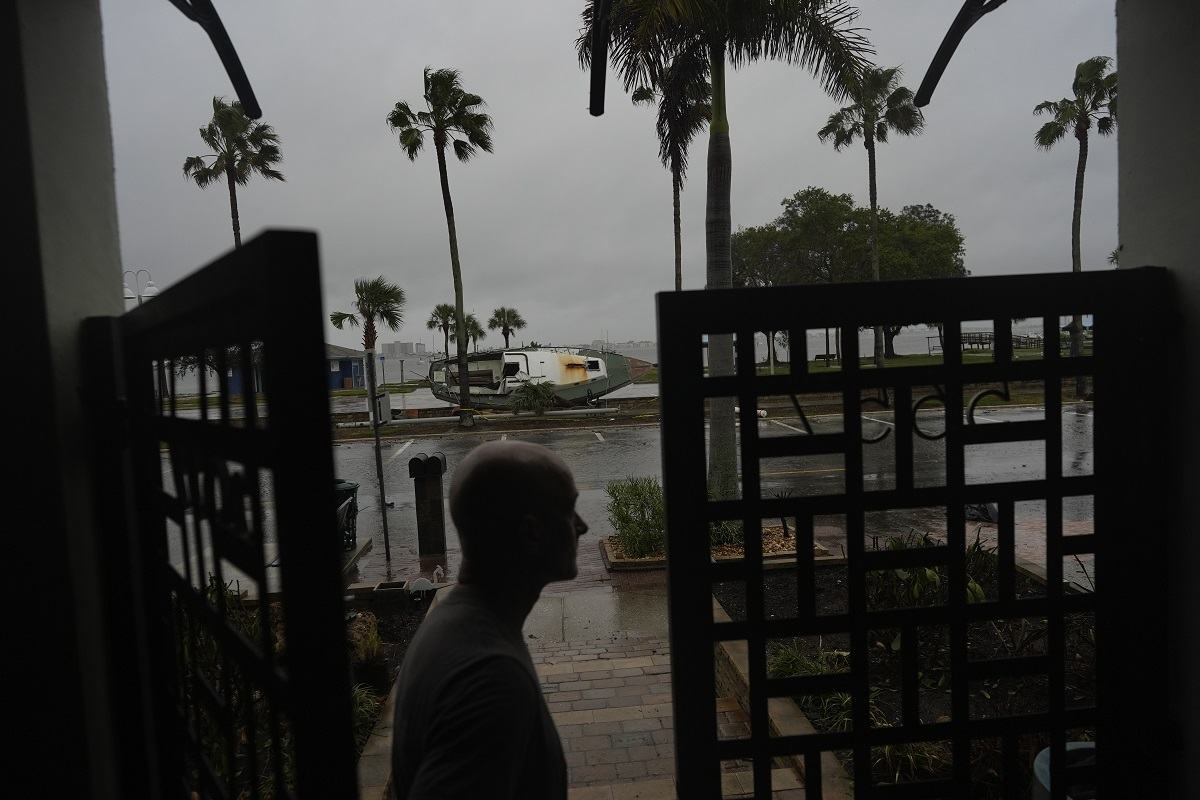
Christian Burke stands at the door of his home, where he, his mother, and his aunt plan to ride out Hurricane Milton on the third floor overlooking overlooking Tampa Bay, in Gulfport, Fla., Wednesday, Oct. 9, 2024.
11:59 JST, October 10, 2024
TAMPA, Fla. (AP) — Hurricane Milton crashed into Florida as a Category 3 storm Wednesday, pounding the coast with ferocious winds of over 100 mph (160 kph), heavy rain and producing a series of tornadoes around the state. Tampa avoided a direct hit.
The cyclone had maximum sustained winds of 120 mph (205 kph) as it made landfall at 8:30 p.m. near Siesta Key, the National Hurricane Center said. Siesta Key is a prosperous strip of white-sand beaches home to 5,500 people about 70 miles (112 kilometers) south of Tampa.
More than 1.5 million homes and businesses were without power Wednesday night in Florida, according to poweroutage.us, which tracks utility reports. The highest number of outages were in Hardee County, as well as neighboring Sarasota and Manatee counties.
The Tampa Bay area has not taken a direct hit from a major hurricane in more than a century, but the storm was still bringing a potentially deadly storm surge to much of Florida’s Gulf Coast, including densely populated areas such as Tampa, St. Petersburg, Sarasota and Fort Myers.
The National Weather Service said flash flooding was occurring in the Tampa Bay area, including St. Petersburg, where over 16 inches (41 centimeters) of rain had fallen.
Heavy rains were also likely to cause flooding inland along rivers and lakes as Milton traverses the Florida Peninsula as a hurricane, eventually to emerge in the Atlantic Ocean on Thursday.
About 125 homes were destroyed before the hurricane even made landfall, many of them mobile homes in communities for senior citizens, said Kevin Guthrie, the director of the Florida Division of Emergency Management.
Multiple tornadoes spawned by the hurricane tore across Florida, the twisters acting as a dangerous harbingers of Milton’s approach. Videos posted to social media sites showed large funnel clouds over neighborhoods in Palm Beach County and elsewhere in the state.
About 90 minutes after making landfall, Milton was centered about 20 miles (30 kilometers) northeast of Sarasota and had weakened slightly with maximum sustained winds of 110 mph (175 kph), becoming a Category 2 storm, the hurricane center reported. It was moving east-northeast at 16 mph (26 kph).
Milton slammed into a Florida region still reeling from Hurricane Helene, which caused heavy damage to beach communities with storm surge and killed a dozen people in seaside Pinellas County alone.
Earlier, officials issued dire warnings to flee or face grim odds of survival.
“This is it, folks,” said Cathie Perkins, emergency management director in Pinellas County, which sits on the peninsula that forms Tampa Bay. “Those of you who were punched during Hurricane Helene, this is going to be a knockout. You need to get out, and you need to get out now.”
By late afternoon, some officials said the time had passed for such efforts, suggesting that people who stayed behind hunker down instead. By the evening, some counties announced they had suspended emergency services.
Milton was expected to remain a hurricane as it plowed across the state, including the heavily populated Orlando area, through Thursday.
The storm threatened communities still reeling two weeks after Hurricane Helene flooded streets and homes in western Florida and left at least 230 people dead across the South. In many places along the coast, municipalities raced to collect and dispose of debris before Milton’s winds and storm surge could toss it around and compound any damage. Surge was projected to reach as high as 9 feet (2.7 meters) in Tampa Bay.
Jackie Curnick said she wrestled with her decision to stay and hunker down at home in Sarasota, just north of where the storm made landfall. But with a 2-year-old son and a baby girl due Oct. 29, Curnick and her husband thought it was for the best.
Curnick said they started packing Monday to evacuate, but they couldn’t find any available hotel rooms, and the few they came by were too expensive.
She said there were too many unanswered questions if they got in the car and left: Where to sleep, if they’d be able to fill up their gas tank, and if they could even find a safe route out of the state.
“The thing is it’s so difficult to evacuate in a peninsula,” she said. “In most other states, you can go in any direction to get out. In Florida there are only so many roads that take you north or south.”
The famous Sunshine Skyway Bridge, which spans the mouth of Tampa Bay, closed around midday. Other major bridges also closed.
At a news conference in Tallahassee, Gov. Ron DeSantis described deployment of a wide range of resources, including 9,000 National Guard members from Florida and other states; over 50,000 utility workers from as far as California; and highway patrol cars with sirens to escort gasoline tankers to replenish supplies so people could fill up their tanks before evacuating.
“Unfortunately, there will be fatalities. I don’t think there’s any way around that,” DeSantis said.
Heavy rain and tornadoes lashed parts of southern Florida starting Wednesday morning, with conditions deteriorating throughout the day. Six to 12 inches (15 to 31 centimeters) of rain, with up to 18 inches (46 centimeters) in some places, was expected well inland, bringing the risk of catastrophic flooding.
One twister touched down Wednesday morning in the lightly populated Everglades and crossed Interstate 75. Another apparent tornado touched down in Fort Myers, snapping tree limbs and tearing a gas station’s canopy to shreds.
Authorities have issued mandatory evacuation orders across 15 Florida counties with a total population of about 7.2 million people. Officials warned that anyone staying behind must fend for themselves, because first responders were not expected to risk their lives attempting rescues at the height of the storm.
St. Petersburg Mayor Ken Welch told residents to expect long power outages and the possible shutdown of the sewer system.
In Charlotte Harbor, about 100 miles (160 kilometers) south of Tampa, clouds swirled and winds gusted as Josh Parks packed his Kia sedan with clothes and other belongings. Two weeks ago, Helene’s surge brought about 5 feet (1.5 meters) of water to the neighborhood, and its streets remain filled with waterlogged furniture, torn-out drywall and other debris.
Parks, an auto technician, planned to flee to his daughter’s home inland and said his roommate already left.
“I told her to pack like you aren’t coming back,” he said.
By early afternoon, airlines had canceled about 1,900 flights. SeaWorld was closed all day Wednesday, and Walt Disney World and Universal Orlando shut down in the afternoon.
More than 60% of gas stations in Tampa and St. Petersburg were out of gas Wednesday afternoon, according to GasBuddy. DeSantis said the state’s overall supply was fine, and highway patrol officers were escorting tanker trucks to replenish the supply.
In the Tampa Bay area’s Gulfport, Christian Burke and his mother stayed put in their three-story concrete home overlooking the bay. Burke said his father designed this home with a Category 5 in mind — and now they’re going to test it.
As a passing police vehicle blared encouragement to evacuate, Burke acknowledged staying isn’t a good idea and said he’s “not laughing at this storm one bit.”
"News Services" POPULAR ARTICLE
-

American Playwright Jeremy O. Harris Arrested in Japan on Alleged Drug Smuggling
-

Japan’s Nikkei Stock Average as JGB Yields, Yen Rise on Rate-Hike Bets
-

Japan’s Nikkei Stock Average Licks Wounds after Selloff Sparked by BOJ Hike Bets (UPDATE 1)
-

Japanese Bond Yields Zoom, Stocks Slide as Rate Hike Looms
-

Japan’s Nikkei Stock Average Buoyed by Stable Yen; SoftBank’s Slide Caps Gains (UPDATE 1)
JN ACCESS RANKING
-

Keidanren Chairman Yoshinobu Tsutsui Visits Kashiwazaki-Kariwa Nuclear Power Plant; Inspects New Emergency Safety System
-

Imports of Rare Earths from China Facing Delays, May Be Caused by Deterioration of Japan-China Relations
-

University of Tokyo Professor Discusses Japanese Economic Security in Interview Ahead of Forum
-

Japan Pulls out of Vietnam Nuclear Project, Complicating Hanoi’s Power Plans
-

Govt Aims to Expand NISA Program Lineup, Abolish Age Restriction


























